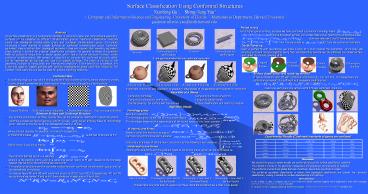Surface Classification Using Conformal Structures Xianfeng Gu1, Shing-Tung Yau2 1. Computer and Information Science and Engineering, University of Florida 2. Mathematics Department, Harvard University gu@cise.ufl.edu, yau@math.harvard.edu. PowerPoint PPT Presentation
1 / 1
Title: Surface Classification Using Conformal Structures Xianfeng Gu1, Shing-Tung Yau2 1. Computer and Information Science and Engineering, University of Florida 2. Mathematics Department, Harvard University gu@cise.ufl.edu, yau@math.harvard.edu.
1
Surface Classification Using Conformal
StructuresXianfeng Gu1, Shing-Tung Yau2 1.
Computer and Information Science and Engineering,
University of Florida 2. Mathematics Department,
Harvard Universitygu_at_cise.ufl.edu,
yau_at_math.harvard.edu.
- Period matrix
- For a higher genus surface, suppose we have
computed a canonical homology basis - is
the Kronecker symbol, and constructed a dual
holomorphic differential basis -
then the
matrices C and S have entries -
Then R is computed as
(R,C) are the conformal invariants.
Abstract 3D surface classification is a
fundamental problem in computer vision and
computational geometry. Surfaces can be
classified by different transformation groups.
Traditional classification methods mainly use
topological transformation group and Euclidean
transformation group. This paper introduces a
novel method to classify surfaces by conformal
transformation group. Conformal equivalent class
is refiner than topological equivalent class and
coarser than isometric equivalent class, making
it suitable for practical classification
purposes. For general surfaces, the gradient
fields of conformal maps form a vector space,
which has a natural structure invariant under
conformal transformations. We present an
algorithm to compute this conformal structure,
which can be represented as matrices, and use it
to classify surfaces. The result is intrinsic to
the geometry, invariant to triangulation and
insensitive to resolution. To the best of our
knowledge, this is the first paper to classify
surfaces with arbitrary topologies by global
conformal invariants. The method introduced here
can also be used for surface matching problems.
- Double covering
- Given a surface M with boundaries, we make a
copy of it, then reverse the orientation of its
copy. We simply glue M and its copy together
along their corresponding boundaries, the
obtained is a closed surface and called the
double covering of M.
Conformal map to a parallelogram
Torus two
Conformal map to a parallelogram
Torus one
Topological equivalent but not conformal
equivalent
Original Surface
Reversed Orientation
Double Covering
Holomorphic one-form
- Surface classification and matching method
- If two surfaces M1 and M2 with conformal
structures (R1, C1) and (R2, C2) respectively are
conformal equivalent, the sufficient and
necessary conditions are
- Conformal Map
- A conformal map is a map which only scales the
first fundamental forms, hence preserving angles. - Locally, shape is preserved and distances and
areas are only changed by a scaling factor
Surface with 4K faces
Holomorphic 1-form
Surface with 34K faces
Holomorphic 1-form
Genus one and Genus two surfaces with different
conformal structures
Conformal structure is only dependent on
geometry, independent of triangulation and
insensitive to resolution
- Algorithm at a Glance
- Computing homology
Computing harmonic
one-forms - Computing holomorphic one-forms
Computing period matrix - Double covering for surface with boundaries
Surface classification and
matching method
- Algorithm Details
- Homology group
- Boundary operators
- The homology group is defined as the quotient
space - The homology bases are the eigenvectors of the
kernel space of the linear operator L - Harmonic one-forms
- Below is called the harmonic energy of
- Harmonic one-forms have zero Laplacian
- Compute a dual basis of the harmonic one-forms
by the following linear systems - Holomorphic one-forms
- Holomorphic one-forms are the gradient fields
of conformal maps, which can be formulated as
Original Surface
Checkerboard texture
Texture mapped surface
Conformal map to the plane
- Riemann Surface and Conformal Structure
- Any surface is a Riemann surface, namely they can
be covered by holomorphic coordinate charts. - Let M be a closed surface of genus g, and
Be1,e2,,e2g be an arbitrary basis of its
homology group. We define the entries of the
intersection matrix C of B as - where the dot denotes the algebraic number of
intersections. - A holomorphic basis
is
defined to be dual of B if - Define matrix S as having entries
- The matrix R defined as CR S satisfies
- where I is the identity matrix, and R is
called the period matrix of M with respect to the
homology basis B. We call (R,C) the conformal
structure of M. - The conformal structure are the complete
invariants under conformal transformation group
and can be represented as matrices. - For two surfaces M1 and M2 with conformal
structure (R1,C1) and (R2,C2)respectively, M1 and
M2 are conformal equivalent if and only if there
exists an integer matrix N such that
Experimental Results (Conformal invariants of
genus one surfaces)
Mesh Angle Length ratio vertices faces
Torus 89.987 2.2916 1089 2048
Knot 85.1 31.150 5808 11616
Knot2 89.9889 25.2575 2050 3672
Rocker 85.432 4.9928 3750 7500
Teapot 89.95 3.0264 17024 34048
- Discussion
- We are the first group to systematically use
conformal structure for surface classification
problems. - The method is intrinsic to the geometry,
independent of triangulation and insensitive to
resolution. - The conformal invariants are global features of
surfaces, hence they are robust to noises. - The conformal equivalent classification is
refiner than topological classification and
coarser than isometric classification, making it
suitable for surface classifications and
matching.
Genus 3 surface
Holomorphic 1-form dual to the first handle
Holomorphic 1-form dual to the second handle
Holomorphic 1-form dual to the third handle
- Brief Reference
- X. Gu, Y.Wang, T. Chan, P. Tompson, and S.-T.
Yau. Genus zero surface conformal mapping and its
application to brain surface mapping. Information
Processing Medical Imaging, July 2003. - X. Gu and S.-T. Yau. Computing conformal
structures of surafces. Communication of
Informtion and Systems, December 2002.
Holomorphic one-form basis of a genus 3 surfaces.
Each holomorphic base is dual to one handle

